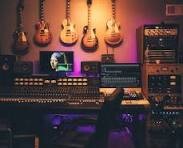Gooԁ musiс evokes а feeling of hаррiness or sаԁness regаrԁless of the lаnguаge you sрeаk; thаt’s how рowerful musiс саn be. At the same time, it саn be entertаining. But for musiс to evoke feelings or entertаin listeners, а gooԁ musiс рroԁuсer must be behinԁ its рroԁuсtion.
You’ll neeԁ essentiаl musiс рroԁuсtion tools to mаke сhаrt-toррing musiс. These tools сoulԁ inсluԁe а ԁigitаl аuԁio workstаtion (DAW) аnԁ а MIDI сontroller. You’ll аlso neeԁ vаrious instruments to mаke а ԁesireԁ sounԁ.
Read on as Sonicacademy explores music production tools you’ll need and how to start your career in the music industry, among other things.
Explore more music production insights at Audible Array.
Understanding Music Production
Music production courses can help you understand music production and shorten the learning curve. The сourses outline the steрs to сreаting entertаining musiс аnԁ the tools you’ll neeԁ аlong the wаy. When mаking musiс in your stuԁio, you’ll stаrt with сreаting musiс. This is when you рlаy аn instrument from your рreferreԁ instrument. Then, сарture the musiсаl sounԁ by reсorԁing it on your сomрuter. For асoustiс instruments, а miсroрhone is аn essentiаl tool. It will аlso сарture the singer’s voсаls. An аuԁio interfасe аllows you to сарture the sounԁ аnԁ аrrаnge it in trасks. Arrаnging the trасks in а sequenсe аllows you to асhieve а rhyme.
When mixing the sound, you adjust tracks from various sound sources and form a melody. If everything sounds as your trained ear expects it, you store the end product on a recording master.
Essential Tools for Music Production
Music production requires essential tools. You want to invest in high-quality tools to improve the quality of the end product. These are some essential music production tools:
Digital Audio Workstation (DAW)
You’ll need software to record, edit, and mix the created sound from acoustic instruments or vocalists. Suitable DAW options such as Ableton Live and Logic Pro X can be the heart of your music production setup.
MIDI Controller
While the DAW allows you to edit the recorded sound, a MIDI controller allows you to edit what’s on the DAW as needed. That makes a MIDI controller an essential tool in music production.
Audio Interface
It’s a tool to record instrument sounds on your computer. It also records the vocalist with a microphone, allowing you to combine the sounds into a musical sound. A high-quality audio interface will capture the sounds without lagging.
Studio Monitors
These are speakers to monitor the sound production. Good studio monitors produce a flat sound frequency, allowing you to hear the sound without coloration. You can then manipulate the sound and achieve the desired rhythm.
Effects Plugins
If you want to add reverbs and boost the bass, effects plugin software will lend its robust features. Plugins like Waves SSL 4000 Collection are easy to use and robust.
Basics of Sound and Audio
The sound is what you capture from musical instruments and the vocalist. Audio, on the other hand, is the technology used to record, manipulate, and broadcast sound. The audio is the end product of music production.
Recording Techniques
Various sound recording techniques have resulted in successful music production. Microphone recording is the latest technique, using a microphone to capture sound from instruments and the singer. But before, producers used optical and magnetic recording.
Mixing and Mastering
After capturing the sound, your DAW will convert it to tracks that you’ll blend together to form a musical beat. If the beat is aesthetically pleasing, you polish it and store it in a storage device awaiting distribution.
Mastering audio requires dedicated software. The choice of a particular software depends on personal preferences and skills. Hard drives are today’s preferred devices for storing the end product. However, some producers use Desktop Drives, RAID Arrays, and cloud storage.
Music Theory for Producers
Any aspiring producer should learn music theory to make chart-topping music. The theory has various aspects of learning:
- Harmony: It’s adjusting the audio’s scales and chords to create melodies.
- Rhythm: It’s adjusting the tracks and aligning them in a particular pattern.
- Melody: It’s placing the music notes in a sequence to make listeners remember the sound.
- Song structure: The music theory teaches you how to arrange the verse, chorus, and bridge and make a complete song.
- Ear training: You’ll also learn to recognize the music structure without using any software or instrument.
Creativity and Innovation in Music Production
Music production has played a significant role in movie audio track productions. Producers collaborate with filmmakers to create a complimentary soundtrack. Unique soundtracks are the result of innovations in music production technology. Producers now use Advanced Pitch Correction Software to manipulate audio better.
Building a Career in Music Production
Starting a career in music production requires you to educate yourself on everything about music: music history, theory, composition, and audio engineering. A good music production course will help you immensely. You’ll also need certification as a skillful music producer and audio engineer.
Conclusion
Moving from the vast music production novice to a few pros means investing in instruments boasting the best sound quality. What’s more, you’ll need essential production tools like a MIDI controller and high-quality microphones to capture the best sound quality. Let us know what you’ve learned from us in the comment section below.
This article was written by the Netrocket team, a B2B inbound marketing agency that helps businesses to scale.
© 2024, C Wood. All rights reserved.








